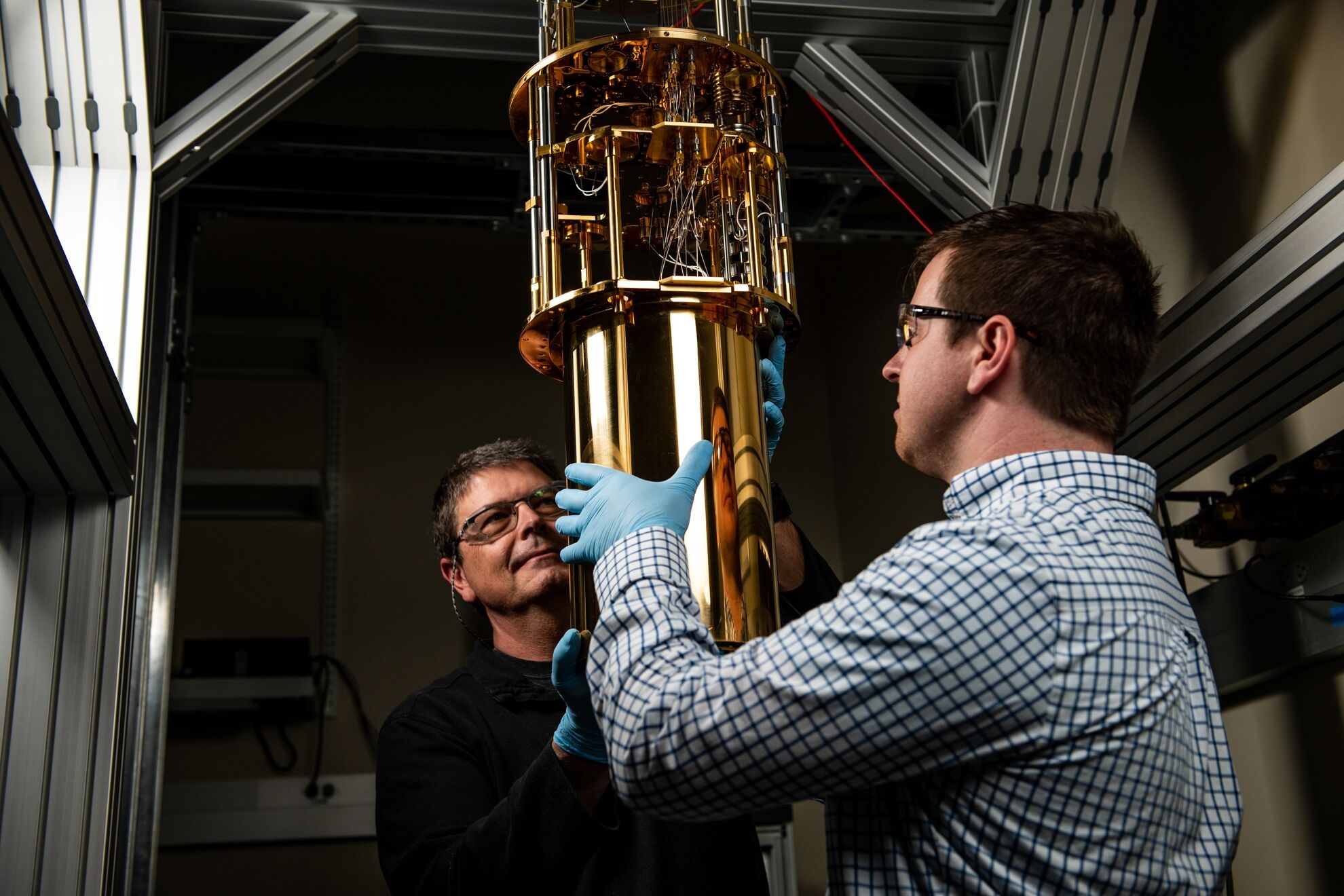CDI News: PNNL Adds Dilution Refrigerator, Capable of Reaching Temperatures Near Zero Kelvin
Return to CDI News & Highlights
April 7, 2020

PNNL researchers engage in a broad range of scientific activities that rely critically on the ability to cool samples and instrumentation to ultra-low temperatures that are only a fraction of a degree above absolute zero.
From materials development for advanced microelectronics to experiments striving to detect dark matter, these efforts depend on the ability to study samples at extremely low temperatures. PNNL researchers now have ready access to a new dilution refrigerator, providing an essential tool to better leverage PNNL’s capabilities toward answering fundamental science questions in the ultra-low-temperature regime.
Initially, the new instrument will be used by project teams within the Chemical Dynamics Initiative (CDI), which are focused on building PNNL’s research portfolio in areas that can benefit from an in-house, ultra-low-temperature capability. The instrument can cool samples from room temperature to 0.01 degrees on the kelvin scale, just a fraction of a degree above absolute zero (about minus 459 degrees Fahrenheit).
It’s a temperature that researchers appreciate, says Richard Williams, a chemist with CDI’s Dynamics of Quantum-Influenced Material Properties project. “Certain materials’ properties are only observable at almost absolute zero,” Williams says. “And those properties are usually what we call quantum-influenced properties.”
Technology in a Nesting Doll
The deep freeze in a dilution refrigerator—a 5-foot-tall instrument with gleaming, gold-plated disc- and coil-filled innards encased in a series of six nesting doll-like shells—may even reveal material properties that are not otherwise evident. Atoms will behave one way at room temperature, but at near-zero kelvin and “the thermal motion of the atoms in a solid material will slow way, way down,” Williams says.
One way to envision a dilution refrigerator’s knack of slowing things down is to envision a track sprinter. Let’s say that sprinter can cover 100 meters in 10 seconds. Williams calculated the hypothetical if that sprinter is placed under the influence of the dilution refrigerator: “The thermal energy inside the dilution refrigerator is at least 10,000 times lower compared to room temperature,” Williams says, while standing next to the refrigerator, performing some on-the-spot math. After double-checking his conclusion, he declared, “The motion of the atoms is reduced by the square root of that, or 100 times lower. Therefore, in this example, the sprinter would take 1,000 seconds to finish the same race or 16.7 minutes.”
PNNL Applications
Williams envisions a broad range of research and development that will utilize the ultra-low temperatures enabled by the new dilution refrigerator. For example, researchers are already making detailed plans for advancing:
- The search for Dark Matter: PNNL is one of many organizations collaborating in the Super Cryogenic Dark Matter Search (SuperCDMS) to directly detect these particles and thus understand the nature of the dark matter. SuperCDMS has its own version of a dilution refrigerator that will be based at SNOLAB (an underground laboratory in Sudbury, Ontario that is 2 km deep) and will be installed with an array of cryogenic, crystalline detectors (6 silicon and 18 germanium) that could capture evidence of dark matter. Related research with the PNNL dilution refrigerator, Williams says, will attempt to leverage PNNL’s expertise in materials science to support the development of advanced detector designs with increased sensitivity to dark matter. Possibilities include measurement and modeling of new materials for detector components, characterization of fabrication methods, and testing of prototype devices.
- Quantum Information Science (QIS): Along with high-tech companies and other institutional labs, PNNL is part of the acceleration of quantum research and development. Dilution refrigerators are an essential component of QIS research. The performance of QIS devices (such as quantum bits, or qubits) can only be improved through a deeper understanding of the physical properties—mechanical, thermal, electrical, and magnetic—of certain key materials, “the building blocks that go into quantum computers,” Williams says. A dilution refrigerator is required for the operation of superconducting qubits—a leading candidate for the construction of scalable quantum computers—and thus, a dilution refrigerator is needed to characterize the qubit materials in the relevant temperature regime. The goal is to couple PNNL’s expertise in materials science, radiation detection, and spectroscopy with the new dilution refrigerator to make QIS advances in microelectronics, quantum sensing, and superconducting qubit design and operations.
1960s Technology, Contemporary Production
Like most modern dilution refrigerators, PNNL’s is cryogen-free, meaning it doesn’t consume cryogenic liquids such as liquid nitrogen or liquid helium. Cryogen-free dilution refrigerators are frequently smaller than systems using liquid reservoirs and are especially well-suited for materials research. Furthermore, they are cost-effective because they do not require a steady supply of liquid helium and they can provide continuous, stable cooling of research samples for weeks to months.
While the technology behind dilution refrigerators has been known since the 1960s, its commercial proliferation is more recent. The company that supplied PNNL’s instrument—BlueFors of Finland—was formed only about a decade ago.